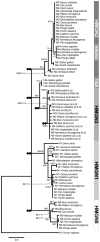Evolution of high mobility group nucleosome-binding proteins and its implications for vertebrate chromatin specialization
- PMID: 25281808
- PMCID: PMC4271525
- DOI: 10.1093/molbev/msu280
Evolution of high mobility group nucleosome-binding proteins and its implications for vertebrate chromatin specialization
Abstract
High mobility group (HMG)-N proteins are a family of small nonhistone proteins that bind to nucleosomes (N). Despite the amount of information available on their structure and function, there is an almost complete lack of information on the molecular evolutionary mechanisms leading to their exclusive differentiation. In the present work, we provide evidence suggesting that HMGN lineages constitute independent monophyletic groups derived from a common ancestor prior to the diversification of vertebrates. Based on observations of the functional diversification across vertebrate HMGN proteins and on the extensive silent nucleotide divergence, our results suggest that the long-term evolution of HMGNs occurs under strong purifying selection, resulting from the lineage-specific functional constraints of their different protein domains. Selection analyses on independent lineages suggest that their functional specialization was mediated by bursts of adaptive selection at specific evolutionary times, in a small subset of codons with functional relevance-most notably in HMGN1, and in the rapidly evolving HMGN5. This work provides useful information to our understanding of the specialization imparted on chromatin metabolism by HMGNs, especially on the evolutionary mechanisms underlying their functional differentiation in vertebrates.
Keywords: HMGN; chromatin; episodic adaptive selection; high mobility group proteins; long-term evolution; nucleosome-binding domain; purifying selection.
© The Author 2014. Published by Oxford University Press on behalf of the Society for Molecular Biology and Evolution. All rights reserved. For permissions, please e-mail: journals.permissions@oup.com.
Figures






Similar articles
-
HMGN5/NSBP1: a new member of the HMGN protein family that affects chromatin structure and function.Biochim Biophys Acta. 2010 Jan-Feb;1799(1-2):86-92. doi: 10.1016/j.bbagrm.2009.09.012. Biochim Biophys Acta. 2010. PMID: 20123071 Free PMC article. Review.
-
Regulation of chromatin structure and function by HMGN proteins.Biochim Biophys Acta. 2010 Jan-Feb;1799(1-2):62-8. doi: 10.1016/j.bbagrm.2009.11.016. Epub 2009 Nov 27. Biochim Biophys Acta. 2010. PMID: 19948260 Free PMC article. Review.
-
H3K27ac nucleosomes facilitate HMGN localization at regulatory sites to modulate chromatin binding of transcription factors.Commun Biol. 2022 Feb 23;5(1):159. doi: 10.1038/s42003-022-03099-0. Commun Biol. 2022. PMID: 35197580 Free PMC article.
-
Distinct properties of human HMGN5 reveal a rapidly evolving but functionally conserved nucleosome binding protein.Mol Cell Biol. 2011 Jul;31(13):2742-55. doi: 10.1128/MCB.05216-11. Epub 2011 Apr 25. Mol Cell Biol. 2011. PMID: 21518955 Free PMC article.
-
Multiple epigenetic factors co-localize with HMGN proteins in A-compartment chromatin.Epigenetics Chromatin. 2022 Jun 27;15(1):23. doi: 10.1186/s13072-022-00457-4. Epigenetics Chromatin. 2022. PMID: 35761366 Free PMC article.
Cited by
-
Biological Functions of HMGN Chromosomal Proteins.Int J Mol Sci. 2020 Jan 10;21(2):449. doi: 10.3390/ijms21020449. Int J Mol Sci. 2020. PMID: 31936777 Free PMC article. Review.
-
Impact of HMGA1 on tumorigenesis, prognosis and immune microenvironment in HNSCC: a multi-omics study.NPJ Precis Oncol. 2025 Aug 2;9(1):269. doi: 10.1038/s41698-025-01068-4. NPJ Precis Oncol. 2025. PMID: 40753128 Free PMC article.
-
Evolution of Methyltransferase-Like (METTL) Proteins in Metazoa: A Complex Gene Family Involved in Epitranscriptomic Regulation and Other Epigenetic Processes.Mol Biol Evol. 2021 Dec 9;38(12):5309-5327. doi: 10.1093/molbev/msab267. Mol Biol Evol. 2021. PMID: 34480573 Free PMC article.
-
Interplay between H1 and HMGN epigenetically regulates OLIG1&2 expression and oligodendrocyte differentiation.Nucleic Acids Res. 2017 Apr 7;45(6):3031-3045. doi: 10.1093/nar/gkw1222. Nucleic Acids Res. 2017. PMID: 27923998 Free PMC article.
-
linc-mipep and linc-wrb encode micropeptides that regulate chromatin accessibility in vertebrate-specific neural cells.Elife. 2023 May 16;12:e82249. doi: 10.7554/eLife.82249. Elife. 2023. PMID: 37191016 Free PMC article.
References
-
- Bergel M, Herrera JE, Thatcher BJ, Prymakowska-Bosak M, Vassilev A, Nakatani Y, Martin B, Bustin M. Acetylation of novel sites in the nucleosomal binding domain of chromosomal protein HMG-14 by p300 alters its interaction with nucleosomes. J Biol Chem. 2000;275:11514–11520. - PubMed
-
- Bianchi ME, Agresti A. HMG proteins: dynamic players in gene regulation and differentiation. Curr Opin Genet Dev. 2005;15:496–506. - PubMed
-
- Birger Y, Ito Y, West KL, Landsman D, Bustin M. HMGN4, a newly discovered nucleosome-binding protein encoded by an intronless gene. DNA Cell Biol. 2001;20:257–264. - PubMed
Publication types
MeSH terms
Substances
Grants and funding
LinkOut - more resources
Full Text Sources
Other Literature Sources
Miscellaneous

